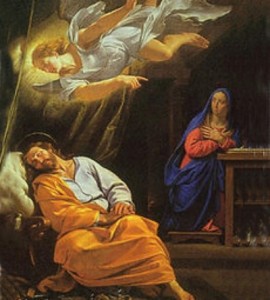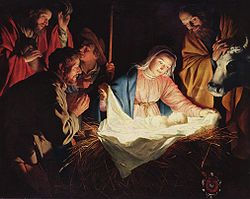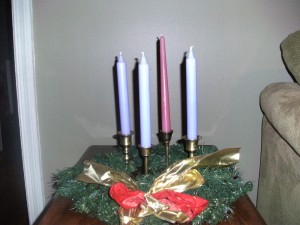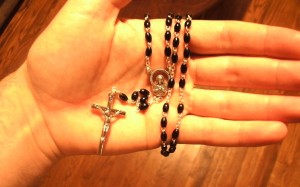Any of us with kids probably remember those last few weeks before our children were born. I was stressed out and excited with both of my girls (and it hasn’t let up yet). There was so much to do and as a young dad, I was terrified. Good thing I had Heather to be terrified with me.
Once we found out we were having girls the shopping and preparation began. Pink this, purple that, flowers over here, and stuffed animals there. We baby-proofed the whole house while family and friends called more and more as we approached the due date. It seemed the entire world was falling in on this one moment, this one tiny person who would change our lives forever.
These weeks and months of waiting and expectation for our kids…that didn’t really happen for Jesus–at least not according to the Gospels. In fact Jesus’ conception was nothing if not a scandal. Mary was shocked and overwhelmed when the angel Gabriel announced that she would bear Christ as a virgin. Mary’s betrothed husband, Joseph, was ready to divorce her in lieu of the unnatural pregnancy until an angel showed up in a dream and convinced him otherwise.

We don’t get a clear picture of what it was like for Mary walking around town as a target for gossip, but I can imagine Joseph and Mary didn’t have it easy socially, even if they were preggers with the Messiah.
The birth of Jesus himself wasn’t a sold-out event either. When my kids were born, we had family and friends in and out of the hospital room and visiting our apartment for days. According to the Gospel of Luke, Christ was born in a “manger” among animals and shepherds. In the Gospel of Matthew, three “magi” visited him (magi are considered astrologers. There is strong evidence that these were actually Zoroastrian priests, which makes the birth of Christ an interfaith gathering!). No family, no big event…the king and creator of the universe and savior of mankind was born to a lowly family, in a lowly place, amid a social controversy that no doubt publicly shamed Joseph and could have had Mary stoned to death.

Two thousand years later, Christians all over the planet celebrate the approach of Christ’s birth as Advent (which comes from the Latin, “Adventus”, meaning “coming”). The time of Advent however, was not always so clear-cut. Advent went through a series of liturgical and developmental growing pains in the many centuries following the rise of the Church in the fourth century. Christians were already celebrating a feast day of Christ’s birth and with close ties in Northern Europe with the Eastern Church, soon a penitential period of fasting rose to prominence. In addition, there was also the Pagan harvest festival of Saturnalia between December 17th and 23rd. A sacrifice was made on the 17th to Saturn, the god of agriculture, and the days afterward were filled with feasts, gifts, and general excess (sound familiar?). The Church soon took this opportunity to sing O Antiphons (titles of Christ) during the Liturgy of the Hours on the sames days as the Saturnalia festival. Toward the end of the 6th century, a longer period extended to four weeks before the Christmas feast in which each Sunday held a particular theme.
Now we have the four Advent Sundays before Christmas. Ta-da!

There are many symbols for Advent, but the Advent wreath appears central. The Advent wreath is actually the Christianizing of yet another Pagan tradition from Northern Europe, but that’s a whole other can of worms. Each candle holds a specific meaning and one it lit each Sunday approaching Christmas. There are no hard, fast rules on colors, but purple and pink/rose are the most popular. The Advent season begins the first Sunday after the feast day of St. Andrew, which is around November 30th.
Several meanings occupy each candle and are meditated and prayed upon after each one it lit. They are:
Candle 1: Prophecy/Readiness: Purple
Candle 2: The Bethlehem Candle/Faith and Confidence: Purple
Candle 3: The Angel’s Candle/ Peace and Enlightenment: Rose or pink (originally called “Gaudete” which means Rejoice)
Candle 4: The Shepherd’s Candle/Joy and Reliance on God: Purple
Many Advent wreaths also have a white candle in the center, lit on Christmas day, in honor of Christ himself.
The evergreen wreath itself can represent the everlasting love of God expressed in the green foliage and the unbroken circle. The increasing number of lit candles from Sunday to Sunday represents the growing light of the one to come who is the “Light of the world.”
That’s the quick and dirty on the season of Advent. A time of expectation and joy for the Savior, it’s an event that we can all understand and appreciate on some level. As parents, we know the feeling of waiting on our child’s birth, but at this time of celebration, we remember the one few celebrated or honored. Jesus, who was “God with us”, was born without fanfare and in the lowest of stations. The irony should not escape us, but for many Christians, the excitement of that birth two thousand years ago has grown cold due to the commercialization of our modern day. But just imagine for a moment the birth of your own children. Imagine the excitement and how it changed your life. Now think about Christ and how his birth changed the lives of everyone.
For non-Christians, this can still be a season of warmth amidst the growing cold, or light within the spreading night. These are symbols we can all embrace together. Just as the Zoroastrians came from afar to celebrate the birth of a Jew who would found the Christian faith, so can we come together from different backgrounds and celebrate peace, joy, and hope.

